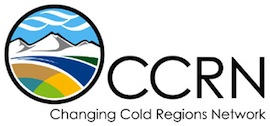
Dr. John Pomeroy
Centre for Hydrology, University of Saskatchewan
Research areas
Research over the last five years has focussed on
i) observing, measuring and detecting change in cold regions basins in the mountains, prairies and North,
ii) developing new observational techniques through expanded hydrological observatories, new snowpack measurement sensors and new methods to collect data from instrumented basins
iii) diagnosing this change using hydrological process models created using the CRHM platform and smaller scale diagnostic models,
iv) better measuring, describing and understanding key cold regions processes,
v) improving models with better process descriptions so that they can more accurately simulate the hydrological cycle in cold regions,
vi) observing and modelling to diagnose extreme events such as floods, anomalous warm period and droughts,
vii) downscaling atmospheric models to predict and diagnose future change due to changing climate, glaciers, permafrost and vegetation in cold regions basins.
Change detection has been based upon ECCC and WECC observatory records. In the eastern prairies, a 14 fold increase in discharge and a change in rainfall-runoff as a fraction of annual runoff from 15% to 55% over 25 years was detected in a wetland dominated basin that had no trend in annual precipitation volume. The increase is attributed to a combination of greater clustering of multiple day rainstorms in early summer, higher rainfall ratio, earlier snowmelt and longer snow-free period, mid-winter melts and rain events restricting infiltration to frozen soils, extensive wetland drainage and resulting increase in contributing area due to channelization of the basin. Contrasting this change was the lack of hydrograph change in a mountain basin that had similar climate change and also application of clear cuts. Here, diagnostic models show counteracting processes of increased evapotranspiration and decreasing low elevation snowmelt runoff versus increasing high elevation snowmelt runoff and the impact of slope and aspect in accelerating melt for clearcuts on south facing slopes whilst decelerating melt for clearcuts on north facing slopes have led to a lack of trends or changes in streamflow regime over 50 years.
The processes of blowing snow transport and sublimation over complex terrain, snowmelt in disturbed forests and on slopes, water flow through snowpacks, glacier snow, firn and ice melt, snow avalanching and freezing and thawing of permafrost soils were incompletely understood, leading to uncertainty in their calculation. Field process studies using particle tracking velocimetry by high speed camera and laser - outdoors at night on mountain tops, snow redistribution measurements over ridgetops, thermal measurements of snow and trees, meltwater pathway development and water flux heterogeneity in snowpacks, snowmelt, firnmelt, icemelt, remote sensing of avalanche redistribution, and active layer dynamics over permafrost were undertaking in the Canadian Rockies, Yukon and NWT.
The Cold Regions Hydrological Model (CRHM) was redeveloped to include improve snow redistribution, melt, glacier, permafrost and hillslope flow components based on the results of field studies. CRHM was applied in Marmot, Wolf, Reynolds, Peyto, Havikpak, Bologna and Smith creeks using observed meteorological data and verified using field observations. It was then used to diagnose hydrological function of these basins, predict and diagnose historical change such as the impact of changing climate, wetland drainage, glacier shrinkage and ice exposure, permafrost thaw and shrubification on hydrological processes, cycling and streamflow hydrographs. It has also been run for late 21st C climates downscaled using statistical and dynamical methods. CRHM outputs show that the loss of cold in these cold regions basins is expected to cause dramatic shifts in the timing, variability and volume of streamflow and even more profoundly, on the processes generating streamflow. There is sometimes compensation by changing vegetation, but also instances where vegetation and wetland drainage change enhance the magnitude of climate change on hydrology.
